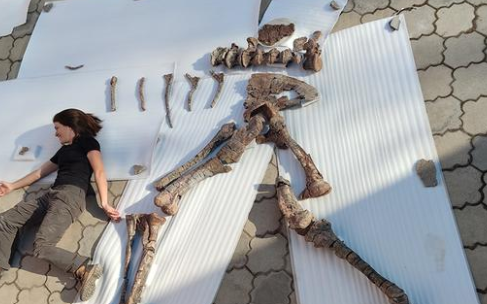A potentially new dinosaur species has been reconstructed from fossils discovered in southeastern Utah, marking an exciting development in paleontology. The remains, estimated to be around 150 million years old, were unearthed by a team from the Natural History Museum of Los Angeles County (NHMLAC) and suggest the existence of a dinosaur species that may be new to science.
The fossils were first discovered in 2007 amidst a collection of bones belonging to various well-known species, including Diplodocus, Stegosaurus, Allosaurus, and Camarasaurus. This “logjam” of bones was initially confusing to researchers, as the remains did not belong to a single dinosaur but rather seemed to be parts of two or more prehistoric reptiles of the same species. This discovery led to the hypothesis that the newly reconstructed dinosaur could be a unique species within the Diplodocus genus, recognized for its long neck and sturdy, four-legged stance.
🚀 New Dinosaur Species Discovered: Scientists uncover Alpkarakush kyrgyzicus, a theropod that bridges key gaps in Jurassic knowledge. 🦖 Explore the past with us! #Paleontology #Science #Dinosaur #Jurassic #TechNews
📢 Follow us for more groundbreaking science news! pic.twitter.com/EK4jwkRNsd— Synergy Solutions LLC (@Synergycorpp) August 31, 2024
The dinosaur has been informally named “Gnatalie” by the excavation team, inspired by the swarms of gnats that plagued the team during their dig. Although the specific identity and classification of Gnatalie are still undetermined, its distinct characteristics and the site’s context suggest it might represent a previously unknown species.
After being prepared at the dig site, the bones were sent to Research Casting International (RCI) in Canada, a prominent organization known for its work in museum displays. RCI was responsible for casting and mounting the skeleton before it was transported to its new display location at the Natural History Museum of Los Angeles County.
Gnatalie, a sauropod, is notable for being the most complete skeleton of its type on the West Coast. The dinosaur measures an impressive 75 feet in length—almost double the length of an average city bus—and weighs around five tons. Remarkably, Gnatalie is also the first green dinosaur skeleton to be displayed anywhere in the world. This green coloration is believed to be the result of volcanic activity from 80 to 50 million years ago, which exposed the bones to extreme heat and led to the formation of a new green mineral that altered the color of the bones.
German and Kyrgyz palaeontologists have discovered the remains of a previously unknown species of predatory dinosaur in the vicinity of the town of Tash-Kumyr, Kyrgyzstan.https://t.co/fJDlzr4TYo#fossils #paleontology pic.twitter.com/qBYa0ZV3nu
— Earth Archives (@EarthArchivesHQ) August 30, 2024
Set to be the centerpiece of a new wing at the Natural History Museum of Los Angeles County, Gnatalie will be unveiled in November as part of a multi-million-dollar exhibition. This display promises to offer visitors an unparalleled glimpse into the prehistoric past, showcasing a unique and possibly new species of dinosaur.
Key Points
i. A new dinosaur species, potentially within the Diplodocus genus, has been reconstructed from fossils found in Utah.
ii. The dinosaur, named “Gnatalie,” was assembled from a mix of bones from at least two specimens, making it a unique discovery.
iii. Gnatalie is the most complete sauropod skeleton on the West Coast, measuring 75 feet in length and weighing about five tons.
iv. The dinosaur’s green coloration is due to volcanic activity millions of years ago that changed the mineral composition of the bones.
v. Gnatalie will be the star attraction in a new wing of the Natural History Museum of Los Angeles County, opening in November.
Kirk Volo – Reprinted with permission of Whatfinger News

